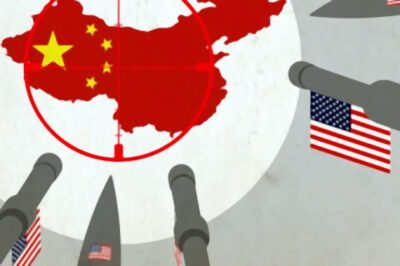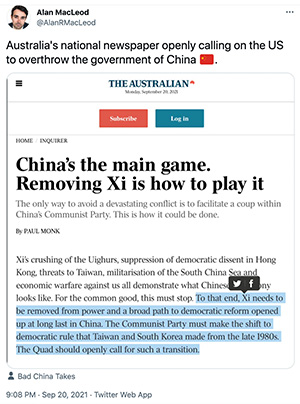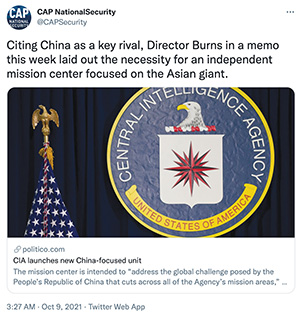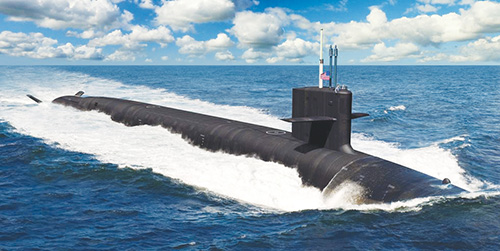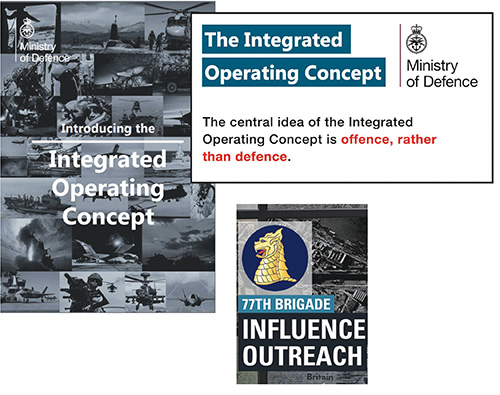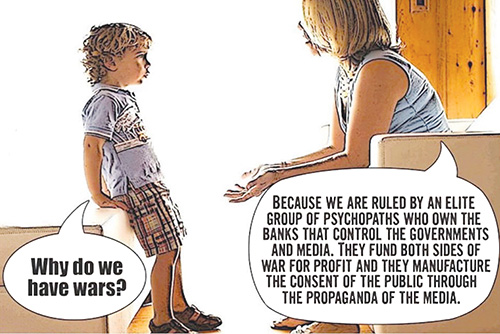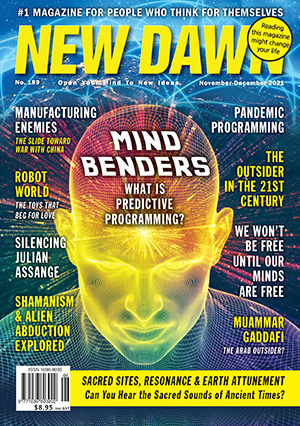From New Dawn 189 (Nov-Dec 2021)
It’s an unthinkable scenario, one which no one in their right mind would want. And yet, we sit on the precipice of the unthinkable: a war with China.
The bellicose rhetoric became more noticeable during the Trump presidency and has since elevated to another level after the Covid crisis. The US and its allies have been steadily building up military capabilities for years in preparation for a major confrontation in the Pacific.
One gets the distinct feeling that China is being groomed for “Axis of Evil” membership, right alongside North Korea and Iran. With ever-increasing frequency, western media dutifully portray Chinese leader Xi Jinping as a ruthless and cunning autocrat. Aside from familiar accusations of ‘Chinese bullying’ in the South China Sea, there is also western charges of ‘genocide’ against the Muslim Uyghur population in China’s Xinjiang Province.
More recently, Western politicians and media blame a “reckless” Chinese Communist Party for unleashing the Covid-19 pandemic on the world. The latter charge may seem hyperbolic, but it’s been most effective in sharply increasing Western hostility towards China.
There is a real fear all this fighting talk will eventually reach a crescendo that sets the two opposing powers on a collision course that could radically transform the global system for the next century and beyond.
It’s no surprise that China would like to see the US out of Asia, but at what cost?
Similarly, in its desire to maintain global hegemony, the United States aims to knock China’s economy and global influence down a peg or two. Would they wage a world war to do it?
At the very least, this has initiated new international arms and cyber warfare races. Will it escalate into an intense hot conflict or a new cold war with lower intensity operations and proxy wars stretching out over decades?
Can this apparent drift towards conflict be averted, or will history repeat itself as superpowers from different hemispheres with two different political and economic visions are drawn into a world war?
Thucydides Trap
Unlike previous US target nations, China is a permanent UN Security Council member and set to surpass the United States as the world’s largest economy and all the global influence that comes with it.
Yet, more than ever, there is a pervading sense that a confrontation between the incumbent western superpower and the emerging power in the east is becoming unavoidable.
This geopolitical phenomenon has been referred to as “The Thucydides Trap,” a term popularised by American political scientist Graham Allison that describes an apparent tendency towards war when one emerging power threatens to displace an existing great power as a regional or international hegemon.
In Ancient Greece, Thucydides was an Athenian historian and military general who believed that the underlying cause of the Peloponnesian Wars was a fait accompli. “It was the rise of Athens and the fear that this instilled in Sparta that made war inevitable,” he explained.
In other words, opposing superpowers invariably find themselves in competition with one another, either in trade or over ideological and cultural supremacy, creating an unavoidable spiral towards confrontation.
This concept implies there are inescapable psychological realities of human dynamics in a world of competing nations. Realist scholar Ken Waltz, the author of Man, The State and War (published in 1959), posited that behind the facade of diplomacy and international relations exists a Hobbesian “state of nature” that is always in a perpetual state of anarchy.
Waltz’s theoretical work is credited with helping form the “bipolar” world order paradigm that dominated intellectual and academic thinking in the West through the Cold War era (1948-1991) and beyond. The bipolar world order was succeeded by a unipolar world order led by the United States and its allies following the rapid collapse of the Soviet Union and its satellite network of countries.
Speaking to the question of the foundational motivation behind the Thucydides Trap, Waltz wrote: “States in the world are like individuals in the state of nature. They are neither perfectly good nor are they controlled by law.”
“Each state pursues its own interests, however defined, in ways it judges best. Force is a means of achieving the external ends of states because there exists no consistent, reliable process of reconciling the conflicts of interest that inevitably arise among similar units in a condition of anarchy.”
“With many sovereign states, with no system of law enforceable among them, with each state judging its grievances and ambitions according to the dictates of its own reason or desire – conflict, sometimes leading to war, is bound to occur.”
As for judging the outcome of any conflict between great powers, Waltz did not hide his cynicism to the point of ambivalence, as he famously remarked:
“Asking who won a given war, someone has said, is like asking who won the San Francisco earthquake. That in war there is no victory but only varying degrees of defeat is a proposition that has gained increasing acceptance in the twentieth century.”
Waltz’s harsh realist worldview never sat well with liberal internationalists and true believers in the United Nation’s global governance system who believe that world peace can one day be achieved through cooperation among nations and interdependency. In many ways, these are two irreconcilable worldviews.
Still, in the absence of that Kantian vision of an international utopia, Waltz does speak to some fundamental truths: why people and nations do what they do, and insights to help us better understand history that may save nations from sliding into undesirable wars.
2025: A Limited Window of Opportunity
A 2016 RAND Corporation document commissioned by the US Army, “War with China: Thinking Through the Unthinkable,”1 outlines likely scenarios with war planners stressing there is a limited window of opportunity to confront China, beginning close in 2025.
After that, they argue China will achieve an irreversible level of global dominance and capability. They state:
“We postulate that a war would be regional and conventional. It would be waged mainly by ships on and beneath the sea, by aircraft and missiles of many sorts, and in space (against satellites) and cyberspace (against computer systems). We assume that fighting would start and remain in East Asia, where potential Sino-US flashpoints and nearly all Chinese forces are located.”
The recently announced UK-Australia-US (AUKUS) defence pact was designed to do just this. Using Australian bases to increase their nuclear submarine capabilities, the US and UK can submerge for more extended periods to threaten the Chinese Navy and ultimately disrupt Chinese shipping lanes and international trade through the Southeast Asian and Pacific region.
As for the nuclear question, geopolitical analyst Brian Berletic explained this polarity in Thucydidean terms in a recent interview: “It’s concerning because these are two nuclear-armed countries… While it’s unprecedented for the US to start an armed conflict directly with a peer, or near-peer competitor, it is also unprecedented that China is now in a position to pass the West.”2
The RAND analysis states that even if nuclear weapons were not used, China would resort to other ways of attacking the United States proper, mainly through space and cyberspace, meaning the public or commercial use of both domains would be severely curtailed during a protracted period of hostilities. However, the US is prepared to deploy smaller lower-yield tactical or ‘battlefield’ nuclear weapons. With a sizeable arsenal already, this would still be a step below high-yield nukes, which both sides would be reluctant to deploy. In such a scenario, whoever struck first would have the upper hand and significant leverage for setting a higher risk threshold than their opponent. Unlike the US, China would want to avoid using any nuclear weapons near its shores.
For the globalists, all this might be a worthwhile sacrifice to make, especially if by the end of a long and costly war a global outcry emerges – clamouring for a One World Government as the final solution to keeping the peace and curing all of our planetary woes.
Target: Belt and Road
The US plan to contain China is nothing new. You can go back to a State Department document from 1965 entitled “189. Draft Memorandum From Secretary of Defense McNamara to President Johnson”:
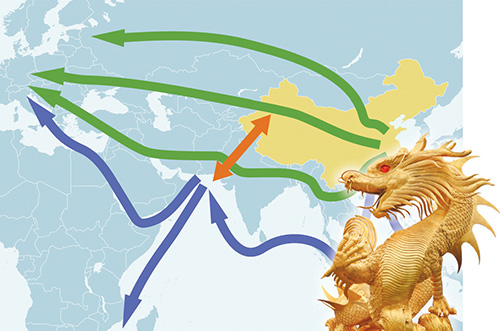
“The February decision to bomb North Vietnam and the July approval of Phase I deployments make sense only if they are in support of a long-run United States policy to contain Communist China. China – like Germany in 1917, like Germany in the West and Japan in the East in the late 30’s, and like the USSR in 1947 – looms as a major power threatening to undercut our importance and effectiveness in the world and, more remotely but more menacingly, to organise all of Asia against us.”3
More than anything else, China’s New Silk Road project, known as the Belt and Road Initiative, worries the Anglo-American world order. Through their ambitious project, China is attempting to develop a vast network of interconnected land and sea transport trade routes to facilitate its future growth.
Western plans like AUKUS are meant to thwart Belt and Road shipping lanes, while other destabilisation operations would be carried out at crucial land access points like Pakistan’s Gwadar port in Balochistan, as well as covert operations in Afghanistan, disruptions in the Persian Gulf, and instability in Africa’s Sahel region, to name just a few.
Interestingly, McNamara’s old memo foreshadowed many of these disruptive operations:
There are three fronts to a long-run effort to contain China (realising that the USSR “contains” China on the north and northwest): (a) the Japan-Korea front; (b) the India-Pakistan front; and (c) the Southeast Asia front.
Myanmar is also a key node in the Belt and Road map with a pipeline transporting fuel from the Bay of Bengal to the Chinese mainland. Operationally speaking, the US views any location that could potentially supply China with resources as a place of interest.
Australia: Deep Port One
In George Orwell’s classic novel 1984, Great Britain was disparagingly referred to as Air Strip One, presumably for functioning as Oceania’s (likely representing a US-led Anglo-American hemispheric order) “unsinkable aircraft carrier” parked on the European fringe.
Similarly, the AUKUS defence pact formalises Australia’s position as an Anglo-American outpost to project power across the Indo-Pacific. Henceforth, Australia becomes Deep Port One, a platform to launch future naval and submarine operations against the People’s Republic of China. This would see an expansion of military operations in Australia’s Northern Territory with ports located around Darwin and possible plans to develop a new facility in Exmouth Gulf in Western Australia.
Former Australian PM Paul Keating vehemently opposed the pact, telling off [the then] PM Scott Morrison, warning in a public statement that it “will amount to a lock-in of Australian military equipment and thereby forces, with those of the US with only one objective: the ability to act collectively in any military engagement by the US against China.”4
The fact that this also makes Australia a bona fide target in an armed conflagration between two nuclear powers is of little concern to the United States, who are set to bill Australia a cool $66 billion for building its new group of nuclear-powered submarines – hardware which will no doubt be managed and staffed by US personnel.
It should be noted this scenario of Australia obtaining nuclear-powered submarines – which is now coming under heavy scrutiny as to its practicability – could be a disinformation ploy to cover up the real strategy.
A report in The Times on 21 September, ‘Britain’s nuclear submarines to use Australia as base for Indo-Pacific presence’, indicates what might be in the works.
“Senior [UK[ government sources said that the AUKUS pact could lead to the Royal Navy’s 1.4 billion pound Astute-class attack submarines undergoing deep maintenance in the region so that they can stay deployed for longer rather than returning to the Faslane naval base in Scotland.”
The Times quoted James Peddell, a former defence technology attache in Washington with experience in submarine technology, who said that a base in Australia could “bring the power of a submarine right up to the doorstep of China… You can bring it in closer, in a stealthy way. You can do intelligence and surveillance, you can project power… and give protection [to surface warships].”
Britain would get to use facilities in Australia to house its nuclear-powered submarines. London is hailing the deal as a victory for its new ‘Global Britain’ brand, but it’s just the latest instalment of Perfidious Albion having another go at the Great Game. If history is any guide, it’s sure to leave a trail of chaos and destruction in its wake.
It’s no secret Australia has always been regarded by Washington and London as a convenient Asia-Pacific backwater colony for its Five Eyes network and global military-industrial complex, most notably its NSA signals intelligence and satellite surveillance base located at Pine Gap, along with joint military bases around the country’s coastal map. This provides the Atlanticist power bloc with a valuable foothold at the gateway to both Southeast Asia and the South Pacific – so the chances they ever release Australia from their political grip is slim to none. Due to its strategic importance, Washington and London always wield influence and power behind the scenes of Australian politics and will orchestrate regime change when the people elect a potentially unfriendly government in Canberra, such as the case of the joint CIA-MI6-ASIO operation in 1975 to remove Labor Prime Minister Gough Whitlam. Award-winning journalist John Pilger recalled, “Australia briefly became an independent state during the Whitlam years.” Since that coup, Washington has determined the whip-line in Canberra.
This controlling influence continued into the Hawke years, confirmed after the declassified release of secret US embassy cables in 2021. A paper by Federation University’s Cameron Coventry on the cables said the Americans valued Hawke because he “helped protect [US] defence installations, provided information about union disputes and warned officials that installations could be targeted.”
Covering the period 1973 to 1979, the cables revealed that Hawke worked intimately with US officials, notably Ambassador Marshall Green, on every key aspect of trade union and Labor policy. Their other preoccupation was how to muzzle rising opposition to the US alliance as a result of the Vietnam War and to protect highly strategic American military-intelligence bases in Australia.
It’s also worth noting that should the US and Britain wish to drag Australia into a war with China, the electorate will have no say in the matter. Nor would there be any debate in Parliament. To declare war, the Prime Minister only needs to notify the Minister of Defence of his plans. Democracy at work.
Taiwan
If a full-blown conflict between the US and China is initiated, the trigger will be over the island of Taiwan, located off the coast of the Chinese mainland.
Along with US allies Japan and South Korea, Taiwan would make the ideal tripartite partner to countering Chinese power in the Pacific. Such an alliance has been discussed but remains a remote fantasy under Beijing’s enormous shadow.
China maintains that Taiwan is rightfully part of the mainland under its “One China” doctrine. Officially named the “Republic of China” with a population of 24 million, Taiwan is a diplomatic conundrum, no longer recognised as an official entity by the United Nations, but receives substantial political, trade and military support from the US, which uses it as the key chess piece on its geopolitical board in the Asia Pacific region.
Many experts believe that by 2025 China plans to seize control over Taiwan, a move that would effectively signal the end of Washington’s predominance in the Pacific and maybe the world. At that point, there would be little the US could do to stem the tide of Beijing.
When America first pledged its support to Taiwan, China was not today’s emerging global superpower. So, has Washington written a cheque which it can no longer cash?
Historian Niall Ferguson writes: “As a student of history, to quote Kissinger, I see a very dangerous situation. The US commitment to Taiwan has grown verbally stronger even as it has become militarily weaker.”5
“Perhaps Taiwan will turn out to be to the American empire what Suez was to the British Empire in 1956: the moment when the imperial lion is exposed as a paper tiger.”
Has the US placed Taiwan in the firing line to realise and protect its own global ambitions? Either way, this part of the puzzle remains complicated but extremely important.
ASEAN is with China
The residents of Southeast Asia, also known as the ASEAN bloc, are not keen on the prospect of a US-led war on China.
Former Malaysian Prime Minister Dr Mahathir Mohamad, interviewed by The Australian Financial Review, commented on the new AUKUS deal: “This agreement indicates you openly regard China as a possible enemy and that, if it comes to the crunch, you might even go to war. Just imagine what war would do to Southeast Asia.”6
Dr Mohamad’s sentiments are likely shared by the rest of the ASEAN neighbourhood – all major trading partners with China and most enjoying cordial relations with Beijing given their very long history of managing China.
As far as Washington and London are concerned, if war is on the cards, then a lack of enthusiasm from ASEAN is a mere inconvenience to be managed.
The Anglo-American tag team would likely fall back on its tried and true methods of creating subservient client states by first sowing chaos and instability, preparing the way for the usual Soros-style colour revolutions, followed by regime change operations. This seems to be the case in Myanmar, with US-backed militants active on the ground and the usual human rights outcry from the media and Western NGOs condemning the government.
With China’s current socio-economic and political trajectory, at best the US and its allies can only hope to play a ‘spoiler’ and disruptor role in the region. Berletic agrees, explaining: “It’s incredibly insecure, it’s paranoid, and it’s pressed for time… It’s a world order trying to project confidence but everything they’re doing is done out of paranoia and done out of fear of being surpassed by China, and they’re inflicting damage on themselves in the process.”
Perhaps America now realises one of the great paradoxes of hegemony. Its biggest advantage during its rise to global dominance in the 20th century was that, unlike its allies, it was prepared to sacrifice a significant amount of blood and treasure to achieve national or corporatist interests, accruing the spoils and kudos of empire required to sustain its dominance over the last 80 years.
This strength became its most significant liability. The current public and political appetite for costly endless wars and interventions is now wearing thinner than at any point since its brief isolationist era in the late 19th and early 20th century. In reality, that political doomsday clock began counting down after the Vietnam War and went further into the red when America invaded and occupied Iraq.
Certainly, the Western public’s appetite for war is not what it was, and in the information age, Western governments are also having a much more difficult time controlling the narrative. In the age of the internet, blogs, and social media, governments can no longer rely on the controlled legacy press to serve up the usual narrow, unchallenged version of events.
Maybe the narrative writers at the new Ministry of Truth can fit up China to fill the role of the new Soviet Union, as per Orwell’s classic line: “The enemy of the moment always represented absolute evil, and it followed that any past or future agreement with him was impossible.”
Hybrid Warfare: A Constant State of War
In his speech to the 2019 Land Warfare Conference, hosted by the Royal United Services Institute (RUSI), Chief of the General Staff of the British Armed forces, General Mark Carleton Smith, unveiled NATO’s new approach to “securing competitive advantage” in an Anglo-American led New World Order.
The General lamented how the rules of warfare are changing and need updating or risk being relegated to a position of outdated “dominant irrelevance” on the global stage.
“The geometry of the battlespace is changing, to the detriment of our conventional military advantage,” he said, referring to “that hybrid space that exists between those two increasingly redundant states, binary concepts, peace and war – artificial and binary characterisations of a strategic context that no longer exists today.”7
In other words, there is no longer such a thing as peacetime or wartime. Instead, reality is redefined as a permanent state of alertness and threat against an amorphous foe known as “the enemy.” This new undefined and constantly evolving hybrid warfare spectrum eerily echoes the constant conflict characterised by Orwell in 1984 as “Oceania was at war with Eastasia. Oceania had always been at war with Eastasia.”
Presumably, these state actor enemies would be Russia and China, with others to be named later.
In their Integrated Operating Concept document, the UK Ministry of Defence further refined its new tactic as “offensive” in nature, rather than traditional defensive and assisting roles.
The new language of war feigns imperial bluster and seems laced with paranoia and doublespeak, protruding through militaristic rhetoric. On these new enemies of the realm, it claims:
“Their strategy of ‘political warfare’ is designed to undermine cohesion, to erode economic, political and social resilience, and to challenge our strategic position in key regions of the world. Their goal is to win without fighting: to achieve their objectives by breaking our willpower, using attacks below the threshold that would prompt a warfighting response. These attacks on our way of life, from assertive authoritarian rivals and extremist ideologies, are remarkably difficult to defeat without undermining the very freedoms we want to protect. We are exposed through our openness.”8
They essentially admit how they’ve lost the battle for ‘hearts and minds’ both at home and abroad. Rather than pause and take a moment for self-reflection on why this happened, the military mindset instead reflexively blames ‘the enemy’ for confusing the unsuspecting electorate in the ‘free’ ‘democratic’ West. You can’t help but notice fascist impulses, yearning to break the tedium of democracy while lamenting how “we” in the West are “exposed through our openness.”
One of the solutions rolled out in response to this new omnipresent “challenge” is to treat free speech, expression, and independent journalism as a threat to their supposed political ‘consensus’ across the Western bloc.
The persecution of Julian Assange and targeting of WikiLeaks can be viewed as the top end of their plan to control the global information commons, but the broader imperative includes everyone – right down to bloggers and individual social media users. Of chief concern is information shared by the general public, questions they are posing to their governments, and independent analysis and opinion that threatens the legacy media monopoly over opinion-forming in the West.
To combat supposed ‘disinformation’ and ‘fake news’, the UK government launched a gaggle of new cyber warfare units like the notorious 77th Brigade and other cyber regiments like the 13th Signal Regiment. Recently, the UK government announced £5 billion to build a new digital warfare centre for “offensive cyber operations.”9 You can’t help but view all this as preparation for a new globalised war.
The authoritarian language is subtle but chilling nonetheless: “The old distinction between foreign and domestic defence is increasingly irrelevant. When ‘fake news’ appears to originate not abroad but at home, it gains credibility and reach, stoking confusion, disagreement, division and doubt in our societies. This has been particularly evident with the significant uptick in disinformation and misinformation during the coronavirus crisis.”10
You can translate “doubt in our societies” to mean targeting everyday dissenting speech or investigative journalism that exposes government and institutional corruption. The state and its military arm are attempting to bracket normal domestic opposition and debate in a democratic society as something in league with ‘malign foreign influences’, an approach not unlike that of Nazi Minister of Propaganda Joseph Goebbels when his political party moved to gain control over press and information in 1930s Germany.
Under the direction of the state, the military is turning its sights on its own population as they attempt to repurpose the heavily politicised ‘fake news’ trope as a pretext to deploy information warfare resources in a domestic theatre and internationally.
More importantly, note how the response to Covid sought to constantly remind the public that we are on a ‘war footing’ in the battle against the virus. Military assets were routinely deployed in public spaces across NATO countries to help with Covid testing, vaccinations, and delivering fuel. In New York, the military backfilled vacancies caused by thousands of medical staff fired for refusing to take the experimental Covid jab.
This is a gradual militarisation of society – during peacetime. Through the construction of a ‘global pandemic’ state of emergency, governments have already established a ‘state of war,’ and so transitioning to an actual hot, warm, or cold war will be seamless; the economic shock has already occurred, expectations of comfort lowered, supply chain severed, travel restricted, borders shut, and rights and freedoms suspended at home, including criminalisation of public gatherings and political protests. Undoubtedly, this would diminish the natural opposition governments expect to encounter when war is declared and things suddenly come to a grinding halt.
The Integrated Operating Concept document continues: “‘Home’ is no longer a secure sanctuary whence we may choose to launch interventions unhindered. ‘Away’ is no longer a regional horizon but a global one, involving space and the electromagnetic spectrum. Similarly, the ‘front’ no longer lies in some distant theatre of operations, but is within the port, airfield, or barracks.”
In true Orwellian fashion, the state’s biggest fear is not some foreign military power but mere information, even at the barracks level, with military brass and civil servants worried that their personnel might be corrupted by something they’ve seen or read online. This is not the rhetoric of a ‘free and open society’ but rather that of highly paranoid totalitarian regimes.
Lurking in the UK National Security Capability Review (2015) are concerns about “the erosion of the rules-based international order, making it harder to build consensus and tackle global threats.”11
Their radical new national security pretext will be backed up by legislation. The government hurriedly implemented its new UK Online Public Safety Bill,12 supposedly designed to protect people from ‘online harms’ like abuse and hate speech by deputising social media firms with new authority to remove ‘harmful’ or ‘illegal’ content. Buried inside the legislation is a move to designate official state narratives as “democratically protected” speech, which means anything challenging official narratives will be removed from parts of the internet they control. How quickly they arrive at this totalitarian determination depends on the ‘emergency’ of the moment, but we already see government directing Big Tech to remove political posts or anything critical of the government or ruling party as they did during and after the 2020 US Presidential Election to protect “public confidence in our election integrity.” At the time, US Democrats and the corporate media painted this as a national security issue.
Invariably, this wide legislative net will further expand to deal with extreme ‘right-wing and leftwing speech’, dangerous ‘conspiracy theories,’ ‘anti-vaxxers’ and ‘medical misinformation’ – all of which is already being judiciously scrubbed from YouTube, Google, Facebook and Twitter. The list of potential ‘harmful’ speech is virtually endless.
The danger cannot be overstated as this type of legislation not only formalises state-corporate censorship but gives carte blanche to unfettered official corruption by shutting down public or journalistic opposition. This is classic fascism.
This ‘threat’ is also used to justify offensive cyber operations to bolster the ‘consensus’ across the NATO bloc. The consensus can be translated as the propaganda de jour propped-up by the government-media complex. Anything threatening is a national security threat. This is precisely what was established at the 2018 G7 Summit in Canada when then-UK PM Theresa May announced the G7 Rapid Response Mechanism, an agreement between member states to streamline public messaging on any issue that might have national security implications. Think the manufactured narratives on the Skripal Novichok attack in the UK, the Douma chemical attack in Syria, or ‘Russian interference’ in western elections. And notice how there was no deviation in the positions of G7 governments on these stories.
This same level of political and informational continuity would become paramount in a time of war and signal the end of sovereign independence for those individual countries. It is pure power politics, complete with entangling alliances and an inability to think and act independently. These were some of the perilous conditions leading to the catastrophic First World War.
The West: Trending Away From Democracy
There is a new and disturbing school of thought creeping into Western discourse. That is, if the West is to defeat or overcome China’s dominance, it needs to become more like China. Since the onset of the Covid crisis and the push to implement draconian new systems like Vaccine Passports, it’s clear that Western governments are embarking on a path towards authoritarian technocracy.
Interestingly, the RAND Corporation’s wargaming exercise troubleshoots antiwar and pro-peace influences in the West, characterising it as a threat to the war effort, or at least something to be overcome or neutralised to prosecute a more successful war. Without explicitly stating it, the tone suggests that war planners view inconvenient features of democratic society as a potential hindrance to realising strategic goals. It’s almost as if they’re saying, ‘If only we could be more like China’, including all necessary domestic systems of social control firmly in place to run a long and unimpeded campaign, at home and abroad.
From a Western wargaming point of view, the current disparity between Chinese ‘totalitarianism’ and Western ‘democracy’ or constitutional republican forms of government gives China a distinct advantage in the ability to control its own population.
The question is finally on the table: how might the West address this issue and still maintain its moral and political high ground as the global standard-bearer for democratic values in their “rules-based international order”?
The signs are indeed worrying as we see a rapid transition by western governments away from democracy and towards establishing rigid totalitarian systems at home. No doubt the ‘global pandemic’ accelerated this transition – the evidence is all around us now.
Heeding the Warning Signs
Just as the Roman legions eventually lost the will to fight and would no longer give their blood for the glory of Rome, so too are America’s warriors approaching that twilight ebb of imperial lineage. Now money and security take precedence over flag and country. As with Rome, the wars fought on the outer rim became increasingly cumbersome and expensive.
Historically, the issue of money has been at the core of sustaining global military dominance. In a long war with China, one of the US-led coalition’s comparative advantages is that the business of war is a much more profitable racket than for China and Russia – as long as the fiat magic money tree is kept fed and watered. Which financial engine will hold up to allow government to maintain an arms race while keeping populations content at home?
Historians typically focus on military status as a metric for an empire in decline rather than the country’s internal societal failings as a prognostic for sovereign decay. For the NATO bloc, and the West in general, the signs are clear: a near exponential growth in the size of government in the last 50 years, a failing and overinflated fiat money system, an increasingly opaque and bloated surveillance state, a more militarised society, an intelligence agency leviathan and entrenched deep state, an increased deference to globalist institutions and governance, the fetishism of identity politics and culture wars, a sinking education system, an incredible wealth gap, the capture of government by industry lobbyists, a corrupt Fourth Estate, and the rise of Silicon Valley’s privatised censorship farms that are subverting and eliminating free speech. Additionally, America is more divided politically now than at any time since the Civil War era, and a divided house cannot stand, let alone fight and win a world war.
Western nations are currently locked into an unforgiving ‘Green’ Great Reset globalist overhaul of their economy and society. It’s a scientific dictatorship by any other name and never voted on or debated in the vaunted parliamentary halls of democracy.
Lastly, should a military showdown occur, China has a home-field advantage which means that while the US and its allies could make life extremely difficult for an extended period on the Chinese mainland, the West will not be able to prosecute a war halfway across the globe forever. With its size, human resources, infrastructure, and food production capacity (near 90% food self-sufficient), China can withstand long-term trade disruptions and the diversion of resources. Moreover, if the West attacks China, this will galvanise domestic support behind the government of Xi Jinping, boosting resilience to China’s defensive posture throughout a protracted conflict. Another important factor is the Anglo-Americans would be waging war on the other side of the globe. This is a fundamental lesson the US coalition should have learned from Afghanistan and the decade-long dirty war against Syria. But have they?
What if the US cannot prevail by conventional means and resorted to unconventional methods to bring its opponent to heel, as they did with Japan during the waning moments of WWII? If conflict commences, there will be those in the US who demand the nuclear option, and like with WWII, the longer the war, the louder the calls from ‘humanitarian’ war hawks to “just drop the bomb and bring this war to an end.” One can only hope that the threat of nuclear retaliation by multiple countries and the grave human and environmental toll to ensue would be enough of a deterrent to Oppenheimer’s “destroyer of worlds.”
As the ascendant power of the moment, China appears to have a slight advantage should a confrontation arise, at least for the time being. But that could change if the US succeeds in fomenting domestic unrest and instability within China’s borders.
For all the reasons cited above, and not lack of military prowess or exotic weaponry, we can expect to see the gradual devouring of America and its allies, and one day, western civilisation too. History also tells us this will likely be a long, painful, drawn-out process, sometimes lasting centuries.
Time will tell, but we would be naïve not to heed the many glaring warning signs at this turning point in history.
Footnotes
1. War with China: Thinking the Unthinkable, www.rand.org/content/dam/rand/pubs/research_reports/RR1100/RR1140/RAND_RR1140.pdf
2. Sunday Wire, Episode 390, 21stcenturywire.com/2021/10/03/episode-390-major-realignments-with-dr-mark-changizi-and-brian-berletic/
3. Draft Memorandum From Secretary of Defense McNamara to President Johnson, history.state.gov/historicaldocuments/frus1964-68v03/d189
4. Why the US-led ‘Aukus’ security pact leaves Australia exposed, Greg Barns, www.scmp.com/comment/opinion/article/3148983/why-us-led-aukus-security-pact-leaves-australia-exposed
5. A Taiwan Crisis May Mark the End of the American Empire, www.bloomberg.com/opinion/articles/2021-03-21/niall-ferguson-a-taiwan-crisis-may-end-the-american-empire
6. ‘You have escalated the threat’: Mahathir blasts Australia on subs, www.afr.com/world/asia/mahathir-aukus-makes-armed-conflict-with-china-more-likely-20210921-p58ti7
7. 2019 Land Warfare Conference, www.youtube.com/watch?v=eoazo5C5My8
8. Integrated Operating Concept (2021), assets.publishing.service.gov.uk/government/uploads/system/uploads/attachment_data/file/1014659/Integrated_Operating_Concept_2025.pdf
9. UK to build £5bn digital warfare centre to mount ‘offensive’ cyber attacks, www.standard.co.uk/news/uk/ben-wallace-cheltenham-boris-johnson-government-lancashire-b958504.html
10. Integrated Operating Concept (2021)
11. 2015 National Security Capability Review, assets.publishing.service.gov.uk/government/uploads/system/uploads/attachment_data/file/705347/6.4391_CO_National-Security-Review_web.pdf
12. Online Safety Bill ‘catastrophic for free speech’, www.bbc.co.uk/news/technology-57569336
© New Dawn Magazine and the respective author.
For our reproduction notice, click here.

